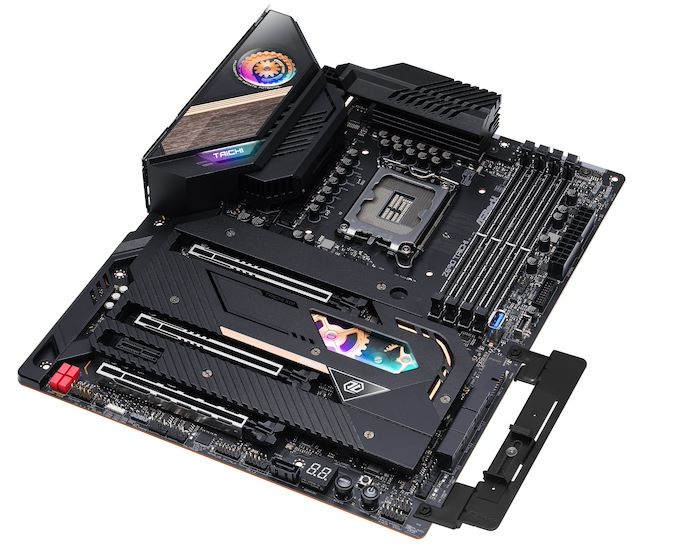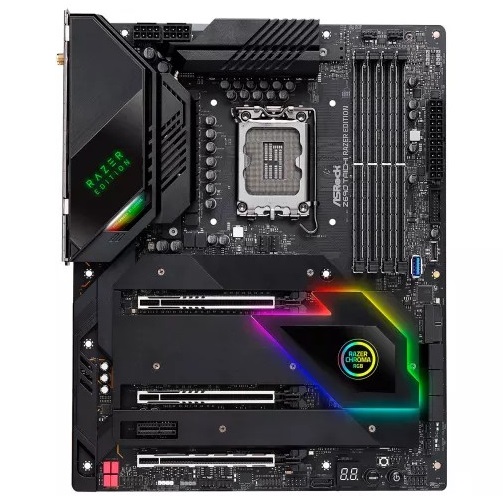The Intel Z690 Motherboard Overview (DDR5): Over 50+ New Models
by Gavin Bonshor on November 9, 2021 9:00 AM ESTASRock Z690 Taichi & Z690 Taichi Razer Edition
Kicking off our Z690 overview in alphabetical order, we'll start with ASRock. ASRock includes its patent-pending ASRock Graphics Card Holder with all of its Z690 models. This is designed to help prevent sagging when used with heavier and long graphics cards.
As it currently stands, the most premium model in ASRock's arsenal for Z690 is from one of its most successful motherboards series, the Taichi. The ASRock Z690 Taichi has a variety of premium features including an advertised 20-phase power delivery with the latest 105 A power stages, as well as a slightly redefined look for 2021. Touching on the design, ASRock includes its mechanical cogwheel effect built into the rear panel cover, which includes RGB LED backlighting, with more RGB built into the cleverly designed cogwheel inspired chipset heatsink.
Looking at the lower portion of the Z690 Taichi, it includes three full-length PCIe slots, including the top two operating at PCIe 5.0 x16 and x8/x8, a third full-length PCIe 4.0 x4 slot, and one PCIe 3.0 x1 slot. Focusing on storage, the ASRock Z690 Taichi includes two PCIe 4.0 x4 M.2 slots, with a third M.2 slot that has support for both PCIe 3.0 x4 and SATA drives. The board also features seven SATA ports in total, with six of these supporting Intel RAID 0, 1, 5, and 10 arrays. Located in the top right-hand corner are four memory slots that can support DDR5-6400, with a combined capacity of up to 128 GB.
The ASRock Z690 Taichi Razer Edition shares the same feature set as the regular Z690 Taichi, but with a Razer-inspired twist. This includes a funky Razer Edition logo on the rear panel cover, with Razer Chroma RGB LED lighting which from the image above, pops really nicely. It drops the cogwheel theme of the Taichi and essentially replaces it with Razer branding.
On the rear panel of the ASRock Z690 Taichi is a pair of Thunderbolt 4 Type-C ports, with two USB 3.2 G2 Type-A, and four USB 3.2 G1 Type-A ports. Onboard audio is handled by a Realtek ALC1220 HD audio codec and ESS Sabre 9218 DAC pairing and consists of five 3.5 mm audio jacks and one S/PDIF optical output. Interestingly, ASRock has put the audio connectors in the middle of the rear panel, as opposed to the end. For networking, ASRock is using a Killer E3100G 2.5 GbE controller, with an additional Intel I219-V Gigabit controller, with a Killer AX1675 Wi-Fi 6E CNVi. Finishing off the rear panel is a single HDMI 2.1 video output and a small BIOS Flashback button.













126 Comments
View All Comments
Duwelon - Tuesday, November 9, 2021 - link
Asus' prices are completely bananas. If I build a new rig with Z690 it'll probably be my first non-Asus build in a very long time.Sivar - Tuesday, November 9, 2021 - link
That caught my eye, too. I bought an Asus Hero-branded board for my current system last year at approximately $200 USD.I suspect Asus is shifting their marketspeak because the word "Maximus" (used for the z690 board but not mine) usually applies to their most expensive boards.
blppt - Tuesday, November 9, 2021 - link
This. $2000 for a consumer grade motherboard? WTF are they smoking?Also, I'm pretty sure ASUS will be releasing some TUF Z690s at some point, probably at a lower price point than the primes. My experience with the TUF series has been very positive for the price.
DigitalFreak - Tuesday, November 9, 2021 - link
They know they're not going to sell many of those. Those boards are either for LN2 e-peen competitions or people with more money than sense.Wrs - Wednesday, November 10, 2021 - link
TUF is historically just a bit more expensive than Prime. They already have a TUF DDR4 version - ordered the Wifi one for $290 the other day. If worried about price DDR5 is the first mistake.blppt - Wednesday, November 10, 2021 - link
The X570 TUF was cheaper than the X570 Prime when I went shopping for an AMD board.COtech - Tuesday, November 9, 2021 - link
Subtitle - "Intel Z690 Chipset: Like Z590, But Now With Native PCIe 4.0"I think "But Now With Native PCIe 5.0" is intended.
gavbon - Thursday, November 18, 2021 - link
The Z690 chipset doesn't have PCIe 5.0, this comes from the CPU. The Z690 chipset does, however, now include PCIe 4.0 lanes, whereas Z590 did not.Someguyperson - Tuesday, November 9, 2021 - link
I don't get the "DP IN" ports on the ASUS ProArt Z690 Creator WIFI. I see the author just wrote what was on the ASUS website, but that doesn't really explain anything. Are they passthrough to the Thunderbolt out ports? Is there a capture card built into this motherboard? I'm very confused by the labeling here.uwsalt - Tuesday, November 9, 2021 - link
Those are passthrough to the Thunderbolt port. Add-in Thunderbolt cards work the same way. You slot in your discrete GPU, send the output from both DP ports to the Thunderbolt controller, and then use Thunderbolt to output to a Thunderbolt monitor or hub.